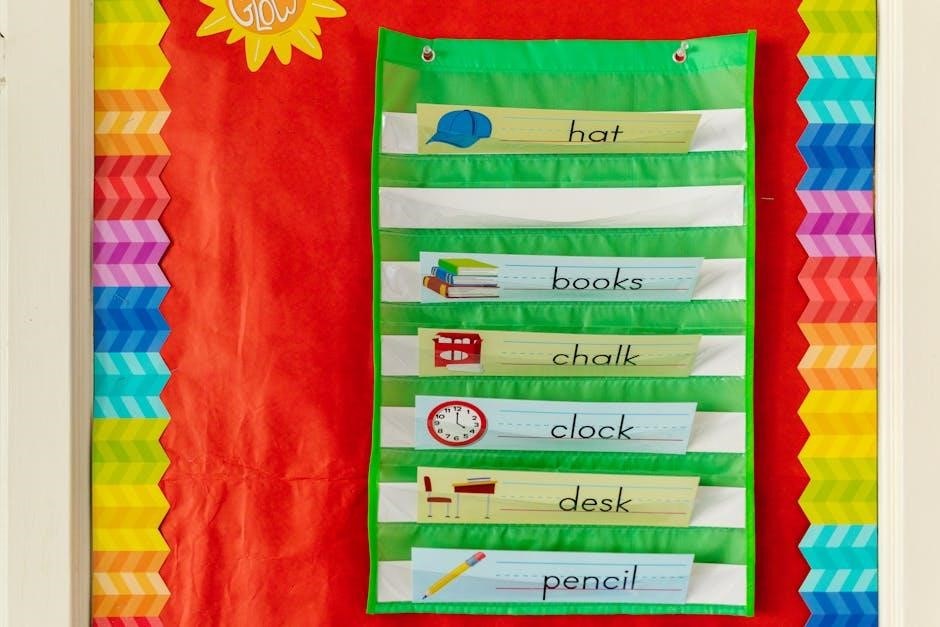alphabet pdf chart
- by blaise

An Alphabet PDF Chart is a visual tool designed to help individuals learn and recognize letters. It is commonly used in educational settings, offering a structured format for understanding the alphabet’s sequence and pronunciation. This resource is particularly beneficial for young learners and language enthusiasts.

What is an Alphabet PDF Chart?
An Alphabet PDF Chart is a downloadable document displaying letters in a structured format. It often includes uppercase and lowercase letters, pronunciation guides, and visuals. This tool aids in learning and teaching the alphabet efficiently, catering to various educational needs.
2.1 Definition
An Alphabet PDF Chart is a digital document designed to display the alphabet in a clear and organized manner. It typically includes both uppercase and lowercase letters, arranged in sequence, and may also feature phonetic pronunciations or visual aids. This chart serves as a reference tool for learning and teaching the alphabet, making it ideal for educational settings. The chart is usually formatted as a PDF file, ensuring it is easily accessible, printable, and sharable across various devices. It may also include additional elements such as images, colors, or interactive features to enhance engagement. The simplicity and structure of an Alphabet PDF Chart make it a valuable resource for educators, parents, and language learners. By providing a standardized format, it helps users familiarize themselves with the alphabet’s sequence, pronunciation, and visual representation. This tool is particularly useful for young children or individuals learning a new language, as it offers a straightforward and visually appealing way to understand the basics of letter recognition and usage.
2.2 Purpose
The primary purpose of an Alphabet PDF Chart is to provide a clear and concise visual aid for learning and teaching the alphabet. It is designed to help individuals, particularly young children and language learners, become familiar with the sequence, pronunciation, and recognition of letters. The chart serves as a foundational tool for early literacy skills, making it easier for users to grasp the basics of reading and writing. Additionally, it can be used to reinforce language learning in educational settings, offering a standardized format that ensures consistency. The chart’s purpose also extends to its versatility, as it can be adapted for various learning environments, including classrooms, homeschooling, and self-study. By providing a structured and visually appealing format, an Alphabet PDF Chart aims to engage learners and facilitate their understanding of the alphabet. Its accessibility and ease of use make it an invaluable resource for educators and learners alike, supporting the development of essential language skills. This tool is particularly effective for visual learners, as it combines simplicity with clarity to enhance the learning experience.
2.3 Structure
An Alphabet PDF Chart typically follows a standardized layout designed to enhance learning and clarity. It usually presents the alphabet in a sequential order, from A to Z, with each letter displayed prominently. The structure often includes uppercase and lowercase versions of each letter, helping users distinguish between the two forms. Many charts also incorporate visual elements, such as images or words that start with the corresponding letter, to aid in association and memory retention. The layout is generally clean and organized, often using grids or tables to ensure readability. Some charts may include additional features like pronunciation guides, making them more comprehensive for language learners. The structure is designed to be visually appealing, with consistent spacing and formatting to ensure that each letter stands out. This organized approach allows users to easily follow along and practice tracing or reciting the letters. The inclusion of images or words further enhances the learning experience by providing context and helping users connect sounds with visuals. Overall, the structure of an Alphabet PDF Chart is tailored to meet the needs of learners, making it an effective tool for education and practice.
2.4 Features
An Alphabet PDF Chart is equipped with various features that enhance its usability and effectiveness. One of the primary features is its clear and legible design, ensuring that each letter is easily distinguishable. Many charts include both uppercase and lowercase letters, along with pronunciation guides to aid language learners. Some charts feature interactive elements, such as clickable letters that produce sounds or animations, making the learning process engaging. Customization is another key feature, as users can often modify the chart to include additional information, such as words starting with each letter or images for visual association. The PDF format allows for easy sharing and printing, making it accessible across different devices. High-resolution visuals and vibrant colors are common features, ensuring the chart is visually appealing. Some charts also offer a grid layout, helping users practice writing the letters themselves. These features collectively make the Alphabet PDF Chart a versatile and user-friendly resource for education and practice.

Benefits of Using an Alphabet PDF Chart

Using an Alphabet PDF Chart enhances learning by providing a clear, visual representation of letters, aiding in recognition and memorization. It supports language acquisition, improves literacy skills, and offers a portable, accessible resource for learners of all ages.
3.1 Educational Value
An Alphabet PDF Chart holds significant educational value, particularly for young learners and those acquiring a new language. It provides a structured and visually engaging way to recognize and memorize letters, which is foundational for literacy skills. The chart often includes uppercase and lowercase letters, along with pronunciation guides, making it an effective tool for understanding letter-sound relationships. Educators use these charts to introduce the alphabet in classrooms, while parents and tutors find them invaluable for personalized learning. The clear layout and visual cues, such as color-coding or images, enhance retention and make learning interactive. Additionally, the portability of a PDF chart allows learners to practice anywhere, reinforcing their knowledge consistently. By focusing on the basics of language, an Alphabet PDF Chart supports early childhood education and lays a strong foundation for future academic success. Its simplicity and accessibility make it a versatile resource for diverse learning environments.

3.2 Design and Aesthetics
The design and aesthetics of an Alphabet PDF Chart play a crucial role in its effectiveness as a learning tool. A well-crafted chart uses vibrant colors, clean fonts, and a logical layout to capture attention and enhance readability. Many charts incorporate visual elements like illustrations or icons to make learning engaging, especially for children. The use of uppercase and lowercase letters side by side helps users distinguish between the two, while color-coding can highlight vowels or consonants for easier identification. High-resolution images and consistent spacing ensure the chart is visually appealing and professional. Some designs also include pronunciation guides or phonetic symbols, adding educational depth. The aesthetic appeal of the chart motivates learners to engage with it repeatedly, making the learning process enjoyable. Whether used in classrooms or at home, a thoughtfully designed Alphabet PDF Chart creates a positive and productive learning environment.
3.3 Versatility
The versatility of an Alphabet PDF Chart makes it a valuable resource for diverse applications. It can be customized to suit various learning needs, such as adding phonetic symbols, images, or translations for multilingual learners. Teachers often use these charts in classrooms to introduce the alphabet, while parents employ them at home for early literacy development. The chart’s digital format allows it to be shared easily via email or cloud storage, making it accessible to remote learners. Additionally, it can be printed in different sizes, from posters for group activities to handheld cards for individual practice. Some versions include interactive features, such as clickable letters that produce sounds, enhancing engagement for tech-savvy users. The chart’s adaptability ensures it remains a practical tool for both traditional and modern learning environments, catering to different preferences and educational goals. Its flexibility in design and functionality makes it a timeless asset for anyone looking to master the alphabet, regardless of age or learning style.
3.4 Accessibility
An Alphabet PDF Chart is designed to be accessible to a wide range of users, ensuring that everyone can benefit from its content. One of its key features is its compatibility with assistive technologies, such as screen readers, which enable visually impaired individuals to navigate and understand the chart. The clear and large font sizes used in these charts make them easily readable for people with visual impairments or dyslexia. Additionally, the structured layout minimizes clutter, reducing cognitive overload for users with learning disabilities. Many Alphabet PDF Charts are also available in multiple languages, catering to multilingual learners and promoting inclusivity. Furthermore, the digital format allows users to zoom in on letters for better visibility, and some versions include audio features that pronounce letters aloud, aiding auditory learners. The portability of the PDF format ensures that the chart can be accessed on various devices, from desktops to tablets, making it a universally accessible tool for education and personal use. These accessibility features ensure that the Alphabet PDF Chart is inclusive and usable by individuals of all abilities and backgrounds.

How to Create an Alphabet PDF Chart
Creating an Alphabet PDF Chart involves designing a layout with letters, images, and optional audio features. Customize fonts, colors, and visuals to enhance readability. Ensure compatibility with assistive tools and print-friendly formats for universal accessibility and educational purposes.

4.1 Planning
Planning is the foundation of creating an effective Alphabet PDF Chart. Begin by defining the target audience, such as young children or language learners, to tailor the content appropriately. Determine the chart’s purpose, whether for classroom use, personal study, or professional training. Decide on the layout and design, ensuring it is visually appealing and easy to navigate. Consider including uppercase and lowercase letters, along with pronunciation guides or images for better understanding. Additionally, plan for accessibility features, such as large text options or compatibility with screen readers. Organize the alphabet in a logical sequence, and think about adding interactive elements if the chart will be digital. Finally, outline the tools and resources needed, such as design software or educational materials, to ensure a smooth creation process. Proper planning will help create a chart that is both functional and engaging for its users.
4.2 Tools
Creating an Alphabet PDF Chart requires the right tools to ensure professionalism and functionality. Design software like Adobe Illustrator or Canva can be used to craft visually appealing layouts and customize fonts. For a more technical approach, programming languages such as Python, paired with libraries like ReportLab, can generate PDFs dynamically. Tools like Microsoft Word or Google Docs are also suitable for simpler designs, allowing easy text formatting and image insertion. Additionally, graphic design tools such as Inkscape or GIMP can help create high-quality visuals for the chart. Online platforms like Visme or Piktochart offer templates for quick and efficient design. For educational purposes, tools like SMART Notebook or Promethean ActivInspire can enhance interactivity. Accessibility tools, such as screen readers, ensure the chart is usable by everyone. Lastly, PDF conversion tools like Smallpdf or Adobe Acrobat can optimize the final document for sharing across devices. Choosing the right tools depends on the creator’s technical skills and the chart’s intended use.

4.3 Visuals
Visuals play a crucial role in making an Alphabet PDF Chart engaging and effective. High-quality images, illustrations, or graphics can accompany each letter, helping users associate sounds with visuals. Using consistent fonts and colors ensures readability and aesthetic appeal. Incorporating pictures of objects that start with each letter enhances learning, especially for children. For example, a picture of an apple for the letter “A” or a cat for “C” makes the chart more relatable. Additionally, icons or symbols can be used to represent letters in a fun and interactive way. The visuals should be clear and large enough to be easily visible, even when the PDF is viewed on smaller screens. Proper spacing between letters and their corresponding images prevents clutter and improves focus. The use of bold or highlighted letters can draw attention to specific details, while subtle background textures can add depth without distracting from the content. Overall, well-designed visuals make the Alphabet PDF Chart both informative and visually appealing, enhancing the learning experience for users of all ages.
4.4 Interactivity
Adding interactivity to an Alphabet PDF Chart enhances its functionality and user engagement. One common feature is clickable buttons or links that trigger actions, such as playing the sound of a letter or displaying additional information. For example, clicking on the letter “A” could play the pronunciation or show a related image. Hyperlinks can connect users to external resources, like videos or websites, for deeper learning. Some charts include animations, where letters or images move or change when interacted with, making the experience more dynamic. Audio integration is particularly useful, allowing users to hear the correct pronunciation of each letter. Interactive quizzes or exercises can also be embedded, enabling users to test their knowledge. These features make the chart more engaging, especially for children or language learners. Additionally, fillable fields or drag-and-drop activities can be included, letting users practice writing or matching letters. Interactivity transforms the chart from a static reference into an immersive learning tool, making it more effective for education and personal use.
4.5 Guide
Creating an effective Alphabet PDF Chart involves following a structured guide to ensure clarity and functionality. Start by selecting a clean, readable font and organizing letters in alphabetical order. Use tools like Canva or Adobe Illustrator for professional design. Include both uppercase and lowercase letters for comprehensive learning. Add high-quality images or icons to visually represent each letter, enhancing understanding. Use a consistent color scheme to maintain visual appeal. Ensure the chart is easily navigable, with clear spacing and alignment. Incorporate pronunciation guides for each letter, especially for language learners. Consider adding interactive elements like clickable buttons for audio or additional information. Test the chart with your target audience to gather feedback and make necessary adjustments. Finally, save the chart in PDF format for easy sharing and printing. By following these steps, you can create a user-friendly and educational Alphabet PDF Chart tailored to your audience’s needs.

Uses of an Alphabet PDF Chart
An Alphabet PDF Chart is versatile, serving educational, professional, and personal purposes. It aids in teaching children and language learners, supports branding and training materials, and assists individuals with learning disabilities; It’s also handy for travel and quick reference needs.
5.1 Education
An Alphabet PDF Chart is an invaluable educational tool, particularly for teaching young children, language learners, and individuals with special needs. It provides a clear, visual representation of the alphabet, making it easier to learn letter recognition, pronunciation, and sequencing. Teachers often use these charts in classrooms to introduce the basics of language, helping students build a strong foundation for reading and writing skills.
In educational settings, the chart can be displayed on walls, shared digitally, or printed for individual use. It supports interactive learning activities, such as tracing letters, matching games, and spelling exercises. Additionally, it aids in teaching phonetics, as many charts include pronunciation guides or images associated with each letter. This visual and auditory combination enhances memory retention and comprehension.

For language learners, an Alphabet PDF Chart serves as a quick reference guide, helping them familiarize themselves with the sequence and sounds of a new language. It is also a useful resource for homeschooling parents and tutors, offering a structured and accessible way to teach the fundamentals of literacy. Overall, its simplicity and versatility make it an essential tool in educational environments, promoting effective and engaging learning experiences.
5.2 Professional
An Alphabet PDF Chart is a versatile tool that also finds applications in professional settings, particularly in fields like graphic design, marketing, and corporate training. Designers often use these charts to create consistent branding materials, ensuring uniformity in typography and visual identity across projects. For instance, it can serve as a quick reference for selecting fonts or verifying letter spacing in design layouts;
In corporate training, the chart is useful for onboarding new employees, especially in industries where attention to detail in documentation or communication is critical. It can be integrated into training modules to teach employees about the correct use of typography or to standardize writing practices. Additionally, it is a handy resource for proofreaders and editors to ensure accuracy in written content.
Professionals in marketing and advertising also benefit from Alphabet PDF Charts when designing campaigns that require precise lettering or stylized text. It can be used to create visually appealing promotional materials, such as posters or brochures, by ensuring alignment with brand guidelines. Overall, its simplicity and practicality make it a valuable asset for professionals seeking to enhance precision and creativity in their work.
5;3 Personal
An Alphabet PDF Chart is a valuable resource for personal use, offering a variety of applications that cater to individual interests and goals. For instance, it can be used as a reference for personal projects, such as creating custom invitations, DIY crafts, or personalized gifts. The chart’s clarity and organization make it easy to select specific letters or designs for artistic endeavors.
Individuals learning a new language or brushing up on their literacy skills can also benefit from an Alphabet PDF Chart. It serves as a handy guide for practicing letter recognition, pronunciation, and spelling. Additionally, it can be a useful tool for personal growth, such as setting goals or creating vision boards, where letters and words are used to convey meaningful messages.
For hobbyists, the chart is a great asset for activities like scrapbooking, calligraphy, or even puzzles. Its portability and accessibility ensure that users can take it anywhere, making it a versatile companion for both creative and practical tasks. Overall, an Alphabet PDF Chart is a simple yet effective tool for enhancing personal productivity and creativity.
Related posts:
Download the free alphabet PDF chart – perfect for learning and teaching! Printable and easy to use.
Posted in PDF